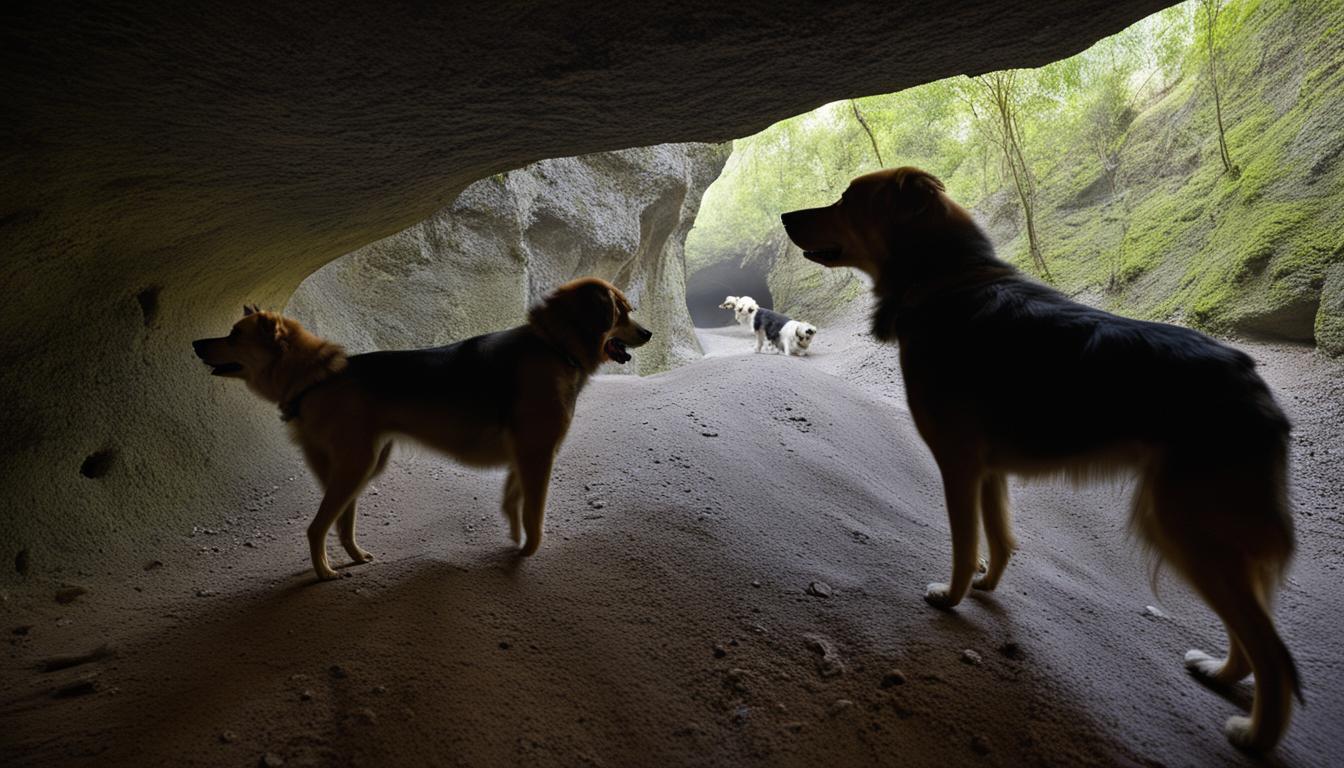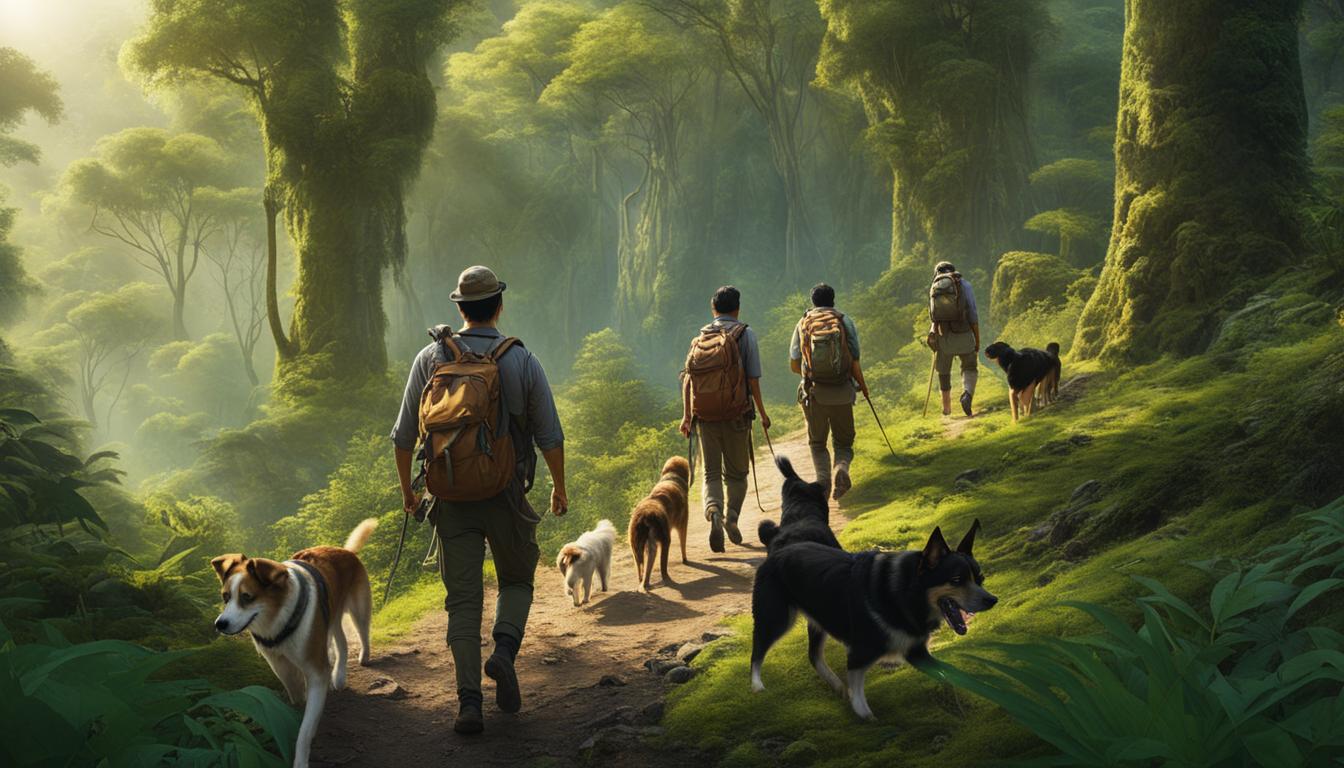Welcome to the wild and untamed Amazon rainforest, where navigating through its dense jungle requires a trusty companion by your side. In the world of Amazonian expeditions, that companion comes in the form of our four-legged friends – dogs! These incredible canines play a pivotal role in rainforest exploration, aiding adventurers like you in your quest to unravel the secrets of this mystical realm.
Key Takeaways:
- Dogs are indispensable in navigating the challenging terrain of the Amazon rainforest.
- They have been part of historic Amazonian expeditions and continue to guide and protect explorers.
- Their adaptability, intelligence, and agility make them ideal companions in this harsh environment.
- Amazonian dogs employ various hunting strategies and thrive in the diverse ecosystem of the rainforest.
- Conservation efforts are crucial to protect their habitat and ensure the survival of these remarkable canines.
The Role of Dogs in Rainforest Navigation
Dogs have played a crucial role in rainforest navigation for centuries, aiding explorers in their journeys through the challenging terrain of the Amazon. With their acute sense of smell, agility, and intelligence, these canines provide invaluable assistance in finding paths, locating wildlife and resources, ensuring the safety of the expedition, and ultimately contributing to new discoveries in the lush wilderness of the rainforest.
These canine companions possess an extraordinary sense of smell, enabling them to detect subtle scents and track hidden trails that would otherwise go unnoticed by human explorers. Their ability to navigate through dense vegetation allows them to lead expeditions to previously unexplored areas, opening up opportunities for scientific research and ecological exploration. Additionally, dogs’ instincts and keen senses help them identify potential threats and dangers, ensuring the safety of the entire expedition team.
Amazonian dogs’ remarkable agility allows them to traverse the challenging rainforest terrain with ease. From scaling trees to crossing rivers, these canines demonstrate exceptional adaptability to the ever-changing environment. Their versatility and quick reflexes make them invaluable companions, capable of overcoming obstacles and guiding explorers through the dense jungle. With their assistance, expeditions can explore and document the rich biodiversity of the Amazon rainforest, contributing to our understanding of this unique and fragile ecosystem.
The Adaptability of Dogs in the Amazon Rainforest
Dogs have shown remarkable adaptability to the harsh environment of the Amazon rainforest. They are invaluable companions in tropical forest expeditions, often accompanying explorers and aiding in their journeys. With their strong survival instincts, ability to swim, and agility in climbing trees, dogs have proven to be well-suited for navigating the dense vegetation and challenging terrain of the Amazon.
Throughout historic Amazonian travels, dogs have played a vital role in assisting explorers in their discoveries. Their keen senses and intelligence make them adept at finding paths, detecting wildlife, and locating valuable resources. Whether it’s tracking down elusive prey or alerting adventurers to potential dangers, dogs are indispensable in ensuring the safety and success of rainforest expeditions.
“Dogs have always been an integral part of our Amazonian journeys. Their unwavering loyalty and adaptability make them the perfect companions in our explorations of the rainforest. They not only guide us through the dense vegetation but also provide a sense of comfort and companionship in this challenging environment.” – Expedition Leader
Dogs in Historic Amazonian Travels
From the earliest Amazonian expeditions to modern-day ventures, dogs have been constant companions. They have adapted to the changing landscape and continue to assist in the exploration and preservation of the Amazon rainforest. The unique bond between humans and dogs has been vital in uncovering the secrets and wonders of this ancient ecosystem.
| Canine Companions in Amazon Journeys | Canines in Tropical Forest Expeditions | Dogs in Historic Amazonian Travels |
|---|---|---|
| Provide guidance through dense vegetation | Aid in discovery of new species | Assist in mapping unexplored areas |
| Alert to potential dangers | Track down elusive prey | Locate valuable resources |
| Navigate waterways and swamps | Ensure safety of expedition members | Offer companionship and emotional support |
The adaptability and contributions of dogs in the Amazon rainforest are a testament to their remarkable skills and the deep bond formed between humans and canines over centuries of exploration. Their presence not only enriches the experiences of those who embark on rainforest expeditions but also highlights the importance of preserving this fragile ecosystem for future generations.

The Hunting Strategies of Amazonian Dogs
One of the fascinating aspects of Amazonian dogs is their exceptional hunting abilities. These canines have developed various strategies to capture their prey in the challenging rainforest environment. With their keen senses and agility, they navigate the dense jungle with ease, making them formidable predators.
Amazonian dogs often employ pack hunting techniques to increase their chances of success. Working together, they coordinate their movements, surround their prey, and execute calculated attacks. This teamwork allows them to bring down larger animals that would be difficult to capture individually.
The hunting skills of Amazonian dogs are further enhanced by their acute sense of smell. Their olfactory receptors are finely tuned to detect scents and track the movements of potential prey. This sensory advantage enables them to locate hidden animals and follow their trails, ensuring a higher success rate in hunts.
Table: Hunting Techniques of Amazonian Dogs
| Hunting Technique | Description |
|---|---|
| Pack Hunting | Collaborative hunting where dogs work together to surround and bring down larger prey. |
| Scent Tracking | Utilizing their highly developed sense of smell to detect and follow the trail of potential prey. |
| Water-Based Hunting | Using their swimming abilities to chase and capture aquatic prey, taking advantage of the region’s waterways. |
| Stealthy Approaches | Employing stealth and camouflage techniques to quietly approach prey, minimizing the chance of detection. |
Additionally, Amazonian dogs are skilled swimmers, and they use this ability to their advantage during hunts. They are known to chase and capture aquatic prey, utilizing the region’s numerous waterways as natural hunting grounds.
Amazonian dogs’ hunting techniques showcase their remarkable adaptation to the rainforest environment. Their pack hunting strategies, keen sense of smell, and agility make them efficient predators in the dense jungle.
Conservation Concerns for Amazonian Dogs
Amazonian dogs, also known as rainforest canines, face numerous threats to their existence due to ongoing deforestation and habitat loss. These activities not only destroy the natural habitat of these dogs but also fragment their territories, making survival and hunting more challenging.
The decreasing population of Amazonian dogs highlights the urgent need for conservation efforts to protect their habitat and ensure their survival. Organizations and initiatives are actively working towards preserving the Amazon rainforest and its diverse wildlife, including these remarkable dogs.
By supporting these conservation efforts, you can contribute to the protection of the delicate balance of the Amazon rainforest ecosystem and help safeguard the future of Amazonian dogs. Through advocacy, education, and sustainable practices, we can raise awareness about the importance of preserving their habitat and mitigating the threats they face.
| Threats to Amazonian Dogs | Conservation Efforts | Protecting their Habitat |
|---|---|---|
| Deforestation | Awareness campaigns | Protected areas |
| Habitat loss | Research and monitoring | Reforestation initiatives |
| Fragmentation of territories | Collaboration with local communities | Sustainable land-use practices |
“The conservation of Amazonian dogs is not just about preserving a single species. It is about protecting the intricate web of life in the rainforest and maintaining the biodiversity that makes the Amazon so unique.” – Dr. Jane Foster, Wildlife Conservationist
Threats to Amazonian Dogs
Deforestation is one of the major threats faced by Amazonian dogs. The clearing of land for agriculture, logging, and infrastructure development leads to the destruction and fragmentation of their natural habitat. As their habitat shrinks, the dogs face increased competition for resources and struggle to find suitable areas for hunting and survival.
In addition to deforestation, habitat loss due to human encroachment poses significant challenges for these canines. As human settlements expand into the rainforest, the dogs’ territories become increasingly restricted, forcing them into smaller areas with limited resources. This further exacerbates their vulnerability and reduces their chances of long-term survival.
Conservation Efforts
To address these threats, various conservation efforts are underway. Awareness campaigns play a crucial role in educating the public about the importance of protecting Amazonian dogs and their habitat. These campaigns aim to foster a sense of responsibility and encourage individuals, communities, and governments to take action.
Research and monitoring initiatives help gather valuable data about the population size, behavior, and habitat requirements of Amazonian dogs. This information is vital for developing effective conservation strategies and ensuring the long-term survival of these canines.
Protecting their Habitat
Protecting the habitat of Amazonian dogs involves establishing and maintaining protected areas within the rainforest. These designated areas provide a safe haven for the dogs and other wildlife, allowing them to thrive and reproduce without disturbance.
Collaboration with local communities is essential for successful conservation efforts. Involving indigenous people who have a deep understanding of the rainforest and its inhabitants can lead to the development of sustainable land-use practices that benefit both humans and animals.
Reforestation initiatives also play a vital role in protecting the Amazonian dogs’ habitat. By planting native tree species and restoring degraded areas, we can contribute to the recovery and regeneration of the rainforest, providing a healthier environment for these canines and other wildlife.
Conclusion
Dogs play a vital role in Amazon Rainforest Expeditions, guiding and assisting explorers in navigating the challenging terrain. Their adaptability, hunting skills, and conservation concerns highlight their significance in the rainforest ecosystem.
These intelligent canines have shown remarkable adaptability to the harsh environment of the Amazon rainforest. With their strong survival instincts, ability to swim, and agility in climbing trees, they make ideal companions in tropical forest expeditions. They have been an integral part of historic Amazonian travels, accompanying explorers and aiding in their discoveries.
Furthermore, the hunting skills of Amazonian dogs are truly remarkable. They employ various strategies and work together in packs to bring down larger prey. Their keen senses and agility help them navigate the dense forest, making them efficient hunters. They also utilize waterways to their advantage during hunts, showcasing their resourcefulness.
However, the conservation concerns surrounding Amazonian dogs cannot be ignored. Deforestation and habitat loss pose significant threats to their existence. By protecting their habitat and understanding their role in the rainforest ecosystem, we can contribute to the preservation of the delicate balance of the Amazon rainforest and its fascinating wildlife.
FAQ
What is the role of dogs in Amazon Rainforest Expeditions?
Dogs play a crucial role in navigating through the dense jungle and providing valuable assistance to explorers. They help find paths, locate wildlife and resources, ensure expedition safety, and aid in exploration and discoveries.
Why are dogs used in rainforest navigation?
Dogs have acute senses of smell, agility, and intelligence, making them invaluable companions in the challenging terrain of the Amazon. Their skills help them navigate the dense forest, find paths, and locate important resources.
How do dogs adapt to the harsh environment of the Amazon rainforest?
Dogs show remarkable adaptability with their strong survival instincts, ability to swim, and agility in climbing trees. These traits make them ideal companions in tropical forest expeditions and historic Amazonian travels.
What hunting strategies do Amazonian dogs employ?
Amazonian dogs are skilled hunters and often hunt in packs, using teamwork and coordination to bring down larger animals. Their keen senses and agility help them navigate the dense forest and catch their prey efficiently.
What are the conservation concerns for Amazonian dogs?
Amazonian dogs face threats due to deforestation and habitat loss. Fragmentation of their natural habitats makes hunting and survival more challenging. Conservation efforts are necessary to protect their habitat and ensure their survival.





